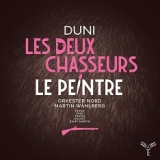Egidio Duni, der 1708 in Matera (Region Basilicata) zur Welt kam, wanderte nach ersten Erfolgen in Italien nach Paris aus, wo er 1775 starb. Jean Monnet, der 1751 die Opéra Comique in Paris leitete, erhielt im Herbst 1756 die Anfrage nach einem Libretto für Duni, der eine Oper für Paris komponieren wollte. Er schickte einen Text von Louis Anseaume, Le peintre amoureux de son modèle (Der in sein Modell verliebte Maler). Die Oper wurde 1757 mit großem Erfolg in Paris uraufgeführt und gilt als Meilenstein in der Entwicklung der Gattung Opéra Comique. Es geht um den Maler Albertio, der sich in sein Modell Laurette verliebt, die jedoch ihr Herz dem Schüler des Malers, Zerbin, geschenkt hat.
Les deux chasseurs et la laitière wurde 1763 uraufgeführt. Das Libretto stammt aus zwei Fabeln von La Fontaine, L’ours et les deux compagnons (Der Bär und die zwei Gefährten), und La laitière et le pot au lait (Das Milchmädchen und die Milchkanne). Zwei Jäger (oder Wilderer?) versuchen vergeblich einen Bären zu erlegen, dessen Fell sie schon gegen ein paar Flaschen Wein eingetauscht haben. Das Milchmädchen, das mitspielt, versucht, die Milch zu verkaufen und scheitert dabei genauso.
Die Musik dieser zweiten Oper ist schon weiter entwickelt als die von Le peintre et son modèle und stellenweise schon viel symphonischer.
Martin Wahlberg dirigiert sein Orkester Nord inspiriert und feinfühlig, gleichzeitig vital und frisch. Die Sänger werden ihren Rollen allesamt gerecht, sie singen frisch und frei, die meisten auch mit Schalk und Humor, so dass für den Hörer zwei vergebliche Stunden garantiert sind. Le peintre amoureux de son modèle wird in Ersteinspielung vorgelegt, und die Interpretation von Les deux chasseurs et la laitière ist jener der einzigen anderen Aufnahme (Brilliant Classics) deutlich überlegen.
Egidio Duni, who was born in Matera (Basilicata region) in 1708, emigrated after initial successes in Italy to Paris, where he died in 1775.
Jean Monnet, who directed the Opéra Comique in Paris in 1751, received a request in the fall of 1756 for a libretto for Duni, who wanted to compose an opera for Paris. He sent a text by Louis Anseaume, Le peintre amoureux de son modèle (The painter in love with his model). The opera premiered in Paris in 1757 to great acclaim and is considered a milestone in the development of the Opéra Comique. It is about the painter Albertio, who falls in love with his model Laurette, who, however, has given her heart to the painter’s pupil, Zerbin.
Les deux chasseurs et la laitière (The two hunters and the milkmaid) was first performed at the Hôtel de Bourgogne in the Théâtre Italien on July 23, 1763. The libretto is taken from two fables by La Fontaine, L’ours et les deux compagnons (The bear and his two companions), and La laitière et le pot au lait (The milkmaid and the milk jug). The two hunters (or poachers?) try in vain to kill a bear whose skin they have already traded for a few bottles of wine. The milkmaid, who plays along, tries to sell the milk and fails just as badly.
The music of this second opera is already more developed than that of Le peintre et son modèle and in places already much more symphonic.
Martin Wahlberg conducts his Orkester Nord with inspiration and sensitivity, at the same time vitality and freshness. The singers all do justice to their roles, singing freshly and freely, most of them also with mischievousness and humor.
So that for the listener two futile hours are guaranteed. Le peintre amoureux de son modèle is presented in first recording, and the interpretation of Les deux chasseurs et la laitière is clearly superior to that of the only other recording (Brilliant Classics).
























